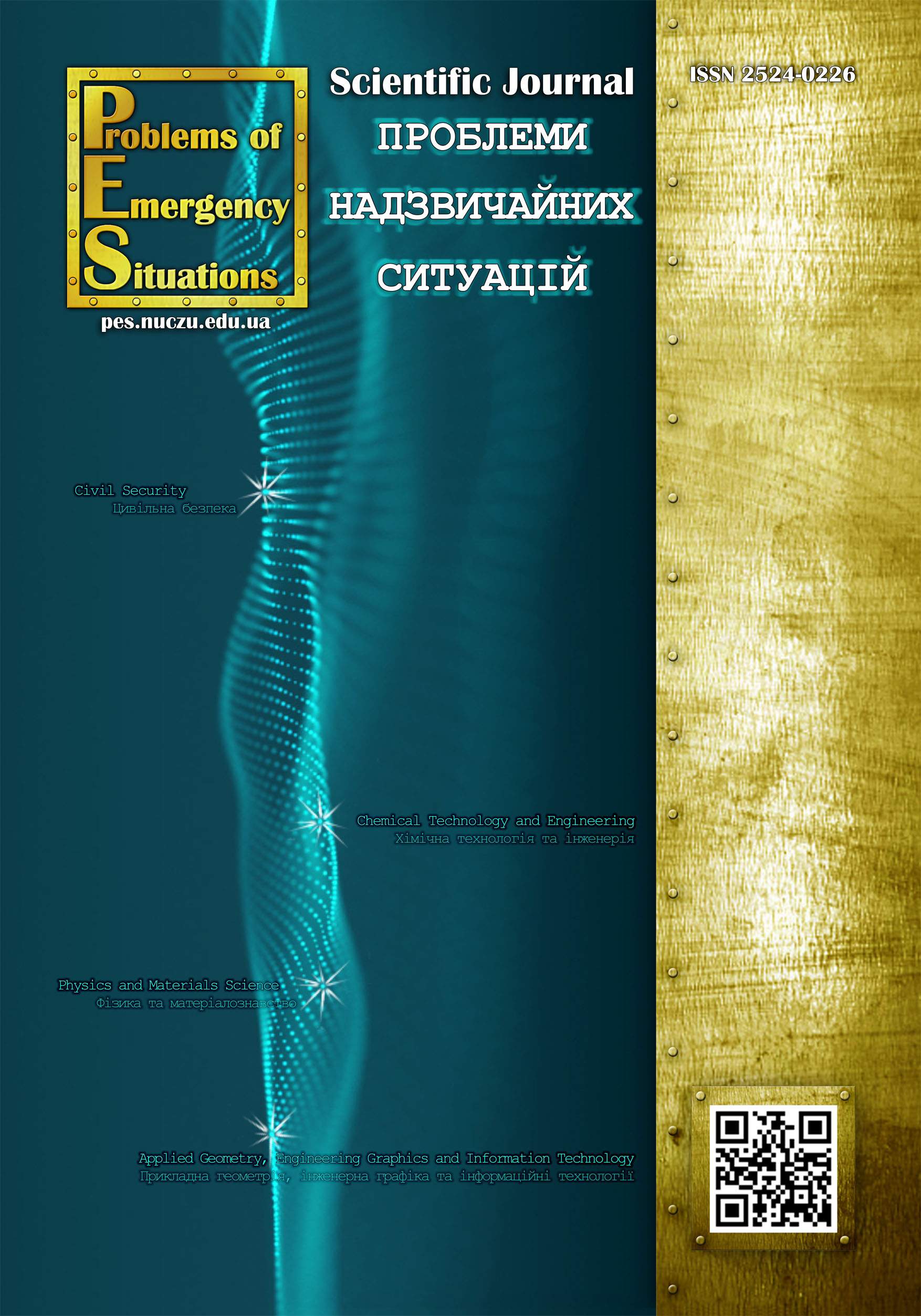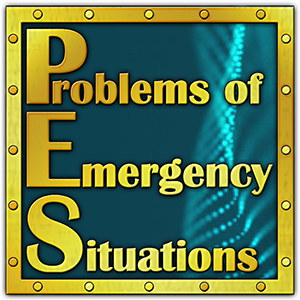The study of the cloging process of stormwater infiltration systems with various filter nozzles
Artemiev Serhii
National University of Civil Protection of Ukraine
http://orcid.org/0000-0003-4535-1990
Rybalova Оlha
National University of Civil Protection of Ukraine
http://orcid.org/0000-0002-8798-4780
Bryhada Olena
National University of Civil Protection of Ukraine
http://orcid.org/0000-0001-5777-8516
Ilinskyi Oleksii
National University of Civil Protection of Ukraine
http://orcid.org/0000-0002-1737-9462
Matsak Anton
National University of Civil Protection of Ukraine
http://orcid.org/0000-0003-2856-9437
DOI: https://doi.org/10.52363/2524-0226-2024-40-15
Keywords: stormwater, clogging, filtration, filtering nozzles, soil, filtration time
Аnnotation
The process of siltation on multilayer infiltration devices during filtration of stormwater runoff has been studied. Silting of devices determines their operational capacity, nevertheless the quantitative understanding of the silting process is quite limited, especially on devices with different filtering noozles. Therefore, a laboratory study of the effluent infiltration process has been conducted to better understand the physical processes of siltation. The silting process has been studied under conditions of a constant water level, with a concentration of suspended solids of 80‑300 mg/dm3 using four filtering nozzles: basalt, sawdust, limestone and polyurethane foam. It has been discovered that the largest layer of silting is formed at the boundary between the filter and the soil due to the formation of a sludge plug, which "protects" the filter/soil boundary. The composition of the sludge plug of the upper layer filtering the volume of the column has been analyzed and it was determined that the physical siltation is mainly caused by migration of sediment particles with a diameter of less than 0.05–0.071 mm (the fraction of which is the main one in the formation of the sludge plug). The issue of distribution of suspended solids according to size throughout the volume of the filtering device has been studied. The main fractions that most adhesion and affect the process of silting devices have been established. Relationships between the rate of infiltration of stormwater runoff and the accumulation of suspended solids in the filter layer has been determined. The lowest rates of decrease in filtration rate have been observed when using limestone (40 %), polyurethane foam and basalt showed similar results (51 % and 55 %), the largest decrease in filtration rate was in sawdust – 74 %. The practical significance of the results of the study lies in understanding the processes of pollution (siltation) of surface runoff treatment devices, which in turn makes it possible to modernize cleaning systems (design, filter nozzles, etc.) and minimize the accumulation of certain fractions of suspended solids on the surface of the watershed.
References
- 1. Liping, J., Binhui, J., Xin, Z. (2014). Research progress on dispersibility in subsurface infiltration system for treatment of domestic sewage. China Institute of environmental sciences, 91(5), 843–854. doi: 10.1145/3070617.307064
- Pan, J., Yu, L. (2015). Characteristics of subsurface wastewater infiltration systems fed with dissolved or particulate organic matter. International Journal of Environmental Science and Technology, (12), 479–488. doi: 10.1007/s13762-013-0408-8.
- Sobotkova, M., Dusek, J., Alavi, G., Sharma, L., Ray, C. (2018). Assessing the feasibility of soil infiltration trenches for highway runoff control on the Island of Oahu, Water, 11(3), 1–19. doi: 10.3390/w10121832.
- Tu, M., Traver, R. (2018). Clogging impacts on distribution pipe delivery of street runoff to an infiltration bed. Water, 10(8), 1–14. doi: 10.3390/w10081045.
- Toran, L., Jedrzejczyk, C. (2017). Water level monitoring to assess the effectiveness of stormwater infiltration trenches. Environmental and Engineering Geoscience. 1–14. doi: 10.2113/EEG-1802.
- Developing Reasonable Assurance: A Guide to Performing Model. (2017). Based Analysis to Support Municipal Stormwater Program Planning: US EPA. Available at: https://www.epa.gov/system/files/documents/2021-12/dev-reasonable-assur-guide-model-base-analys-munic-stormw-prog-plan-2017-02.pdf.
- Improving Stormwater Program Monitoring, Evaluation. (2018). Tracking, and Reporting: Workshop Report and Recommendations, Chicago, USA. Available at: https://www.epa.gov/sites/default/files/2018‑10/documents/improving_stormwater_program_monitoring-10-12-2018.pdf.
- Better Assessment Science Integrating Point & Non-point Sources Modeling Framework: National Exposure Research Laboratory, RTP, North Carolina: Available at: https://www.epa.gov/hydrowq/better-assessment-science-integrating-point-and-non-point-sources-basins
- Selbig, W. R. (2015). Characterizing the distribution of particles in urban stormwater: advancements through improved sampling technology. Urban Water Journal, 12(2), 1–11. doi: 10.1080/1573062X.2013.820334.
- Rossman, L., Huber, W. (2015). Storm Water Management Model Reference Manual Volume I: US EPA Office of Research and Development, Washington, DC. Available at: https://cfpub.epa.gov/si/si_public_record_report.cfm?Lab=NRMRL&dirEntryId=309346.
- Pitt, R. E., Clark, S. E., Eppakayala, V. K., Sileshi, R. (2016). Don’t throw the baby out with the bathwater: sample collection and processing issues associated with particulate solids in stormwater. Journal of Water management and Modeling, 1–13. doi: 10.14796/JWMM.C416
- Petrucci, G., Bonhomme, C. (2014). The dilemma of spatial representation for urban hydrology semi-distributed modelling: trade-offs among complexity, calibration, and geographical data. Journal of Hydrology, 1–53. doi: 10.1016/j.jhydrol.2014.06.019
- Mercado, J. M. R., Maniquiz-Redillas, M. C., Kim L. H. (2015). Laboratory study on the clogging potential of a hybrid best management practice. Desalination Water Treat, 3127–3133. doi: 10.1080/19443994.2014.922287
- Kandra, H. S., McCarthe, D., Fletcher, T. D., Deletic, A. (2014) Assessment of clogging phenomena in granular filter media used for stormwater treatment. Journal of. Hydrology, 1–10. doi: 10.1016/j.jhydrol.2014.03.009
- Segismundo, E. Q., Koo, B. H., Lee, B. (2016). Effects of Media Breakage on Infiltration Characteristics in Stormwater Management System. Journal of the Korean Geotechnical Society, 31–41. doi: 10.7843/kgs.2016.32.2.31
- Segismundo, E. Q., Kim, L. H., Jeong, S. M., Lee, B. S. (2017). A Laboratory Study on the Filtration and Clogging of the Sand-Bottom Ash Mixture for Stormwater Infiltration Filter Media. Water, 32. doi: 10.3390/w9010032
- Segismundo, E. Q. (2016). Experimental Analysis of Particle Breakage and Clogging Potential for Granular Filter Media Used in Stormwater Management Systems. Master's thesis, 1–10. Available at: https://hal.science/hal-03296735/document
- Mercado J. M. R., Maniquiz‑Redillas M. C., Kim L. H. (2017) Assessment and development of design criteria for a hybrid stormwater treatment system. Desalination and Water Treatment, 418–424. doi: 10.5004/dwt.2017.11447
- Kandra, H. S., Deletic, A., McCarthy, D. (2014) Assessment of Impact of Filter Design Variables on Clogging in Stormwater Filters. Water Resources Management, 1873–1885. doi: 10.1007/s11269-014-0573-7
- Lee B., Kim L.H., Jeon P.G., Segismundo E. (2014). Modeling of Suspended Solid Clogging of Porous Media in Urban Stormwater Infiltration Facility. Journal Korean Society, 427–437. doi: 10.9798/KOSHAM.2014.14.6.427.
- Minnesota council. (2016). Operation and maintenance of infiltration trench. In Minnesota. Stormwater manual, Minnesota: MC. Available at: https://stormwater.pca.
state.mn.us/index.php/Operation_and_maintenance_of_stormwater_infiltration_practices - El Mansouri, B. (2015). Enhancement of groundwater potential by aquifer artificial recharge techniques. Climate change, 155–156. doi: 10.5194/piahs-366-155-2015
- Sadiki, M. L. (2019). Improvement of groundwater resources potential by artificial recharge technique: a case study of charf el Akab aquifer in the Tangier region. Journal of Groundwater Science and Engineering, 7(3), 224–236. doi: 10.19637/j.cnki.2305-7068.2019.03.003
- El Mezouary, L. (2020). Coupling of numerical flow model with the Susceptibility Index method to assess the groundwater vulnerability to pollution. Water Resources, 1–5. doi: 10.1145/3399205.3399246
- El Mezouary, L. (2015). Modélisation numérique de la variation saisonnière de la qualité des eaux souterraines de l'aquifère. Magra Italie, 25–31. doi: 10.1051/lhb/20150015
- Marla, C. M, So-Young, L., Lee Hyung, K. (2014). Long-Term Monitoring of Infiltration Trench for Nonpoint Source Pollution Control. Water Air Soil Pollution,(212), 13‑26. Available at: https://www.scirp.org/(S(351jmbntvnsjtlaadkozje))/reference/referencespapers?referenceid=1347469
- Kandra, H. S., McCarthy, D., Fletcher, T. D., Deletic, A. (2014). Assessment of Clogging Phenomena in Granular Filter Media used for Stormwater Treatment, Journal of Hydrology, 518–527. doi: 10.1016/j.jhydrol.2014.03.009.
- Yong, C. F., McCarthy, D. T., Deletic, A. (2013). Predicting Physical Clogging of Porous Permeable Pavements, Journal of Hydrology, 48–55. doi: 10.1016/j.jhydrol.2012.12.009
- Atlabachew, A., Shu, L., Wu, P., Zhang, Y., Xu, Y. (2018) Numerical modeling of solute transport in a sand tankphysical model under varying hydraulic gradient and hydrological stresses. Hydrogeololgy Journal, 2089–2113. doi: 10.1007/s10040-018-1758-6
- Matsak, A. O. (2021). Improving the level of environmental safety of water bodies by reducing the impact of rainwater from urbanized territories (diss. cand. tech. science). Ukrainian Scientific Research Institution of Ecological Problems, Kharkiv, Ukraine. Available at: https://uacademic.info/ua/document/0421U100725
- Rybalova, O. V., Matsak, А. O. (2018) Natural methods of surface runoff treatment. Third International Conference of European Academy of Science, 85–86. Available at: http://repositsc.nuczu.edu.ua/bitstream/123456789/8806/1/Natural%20methods%20of%20surface%20runoff%20treatment.pdf
- Matsak, A. O. Tsytlishvili, K. O. (2018). Using different filter media of stormwater treatment performace. Norwegian Journal of development of the International Science,19‑23. Available at: https://www.calameo.com/read/005798408dafeae98e9ba
- Gorban, N. S., Zinchenko, І. V., Matsak, A. O. (2015). Improving the environmental safety of water bodies by using methods of preliminary treatment of stormwater. Problems of environmental protection and environmental safety, 87–90. Available at: http://www.niiep.kharkov.ua/node/2760
- Solid fuel. Method of sieve particle size distribution: DSTU 4082-2002. (2006). Kyiv. Available at: https://online.budstandart.com/ua/catalog/doc-page?id_doc=75811
- Methodology for measuring the mass concentration of suspended matter: RND 03‑05‑2002. (2002). Kharkiv. Available at: https://zakon.rada.gov.ua/rada/show/v0107508-04#Text














